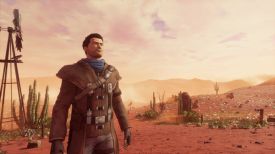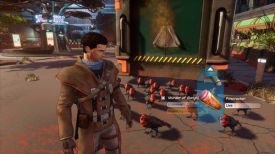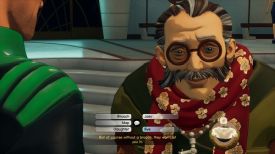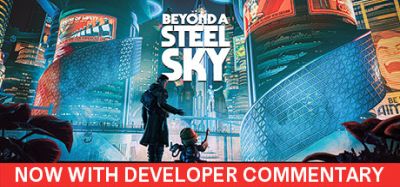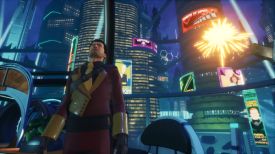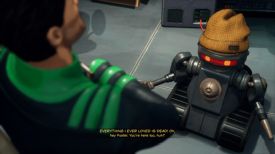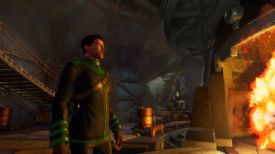|
By flotsam
Beyond A Steel Sky
Revolution Software
Its been more than 25 years
since Beneath A Steel Sky was released, and nearly 20 since I played and
reviewed it. Now here we are with a sequel, set a comparatively mere 10
years after the events of the original, and despite the passage of time
not only are the main characters still with us, so is the creator, the
artist and the developer. With all that “history” going on, indulge me a
bit more. Or just skip the next paragraph.
I had never heard of Artic
Software until I started collecting games, and didn’t own any of the
systems you needed to play their games, but I now have a number of their
games on tapes for both the ZX Spectrum and the C64, several of which
were written by Charles Cecil. Who then founded Revolution, via a stint
with Activision, for which Beneath a Steel Sky was their second game,
conceived by Cecil and drawn by Dave Gibbons (of Watchmen renown). They
have both achieved much in their fields since then.
The game casts you as Robert
Foster, returning to Union City in search of a kidnapped child. A
resident of The Gap - the vast spaces in between cities - when we left
Foster he had “liberated” the city, and left his AI companion Joey in
charge of establishing a “happy” future.
That much of the backstory is
covered in a comic book style introduction, and you might also pick up
that the setting is Australia (Gang-Gangs, the windmills and the dodgy
accents). There are other clues throughout (a reference to Asio) but
other elements, including how Robert got his second name, will elude
you. In that regard it is probably worth watching the opening part of
the earlier game online.
Having said that, there is much
of the old game that resonates here, and while you don’t need to have
played it to play this, at the time of writing the earlier one was free
on both Steam and GOG. Its worth a play in any event, and you will also
appreciate some of the (dare I say) LINC-ages.
While events begin in the
desert, the game takes place in Union City, once you work out a way to
get inside. We have all experienced a utopia run by AI, so it should
come as no surprise that most everything is monitored and managed,
meaning a Gaplander like Foster can’t just walk in. A U-chip, a hacked
identity and a few other things will be required. He can worry about his
Qdos score – which indicates his social standing and as a result
determines all manner of things – at a later point.
What starts as a mission to find
the child becomes a quest to uncover and deal with something far more
sinister. What that is largely comes towards the end, but there are
inklings as you go, and some important reveals along the way.
It plays in the third person,
utilising the WASD keys to get around and the mouse to “look”, an
arrangement well suited to “realistic” exploration of an elaborate 3D
world. There are plenty of places and locations to explore, some more
dingy and run down than others, but it’s a visually exciting place to
run around in. It has a very definite comic book aesthetic, accentuated
by the opening cutscene and the introspective “panels” in a number of
the others. There is so much going on that even when its just you alone
with the detailed imagery, it never gets dull.
The 46 piece orchestrated
soundtrack is a big plus, not just in its composition but in how its
used. It sits underneath things, never overwhelming, and only
occasionally asserts itself into proceedings, with resultant great
effect. Too often the music is overdone, be it games, tv or movies, and
while my preference is always for less, when used like this it is very
effective.
Voice acting is also polished,
especially for Foster, and while some are a tad overdone, on the whole
these seem deliberately so, a product of the type of character being
portrayed. d-RYDs are everywhere, not just for colour and movement, and
human characters abound as well. Dialogue is sharp, frequently witty,
often sarcastic, especially when Joey is about.
Not the god-like Joey, but the
Foster sidekick that ends up inhabiting whatever spare machine happens
to be about. How all that comes to pass you can discover for yourself,
but Joey is as much fun as ever.
As you explore, the outline of
little opaque discs will appear on things, and as Foster notices them,
the outline will become solid, and an identifying label will pop-up. Get
close enough and the disc will fill and spin, indicating you can now
interact with it. Click to generate one or more action tags (mainly
examine or use) and select the one you want. If the inventory tag is
present, selecting that will enable you to cycle through your items,
having the option (possibly) to use them on that particular item. The
same dynamic occurs for characters, and choosing the talk tag will
generate various conversation topics, which in turn might generate
additional topics. Just pick and choose until you have had enough
(exhausted topics will be opaque), then click “bye” and the conversation
will end. It can be a bit busy at times but it works rather well.
Foster also obtains a hacking
tool early on, and right clicking will bring up the tool. Like the
little discs, opaque squares will appear on items that can be hacked,
again filling and spinning when in range. The tool can also indicate
that such an item is eg 6m away in a particular direction. Clicking a
spinning square will give you the capacity to use your tool on the item
or items involved.
I say items because the more
complicated hacks require you to have more than one item within range,
in order to swap LOGIC and/or TASK and/or DATA blocks amongst them
(fiddle with the code if you will). The help function within the tool
explains in more detail (and is a handy reference for what you are
doing), but essentially you are using the programming information in one
item to make another item behave the way you want it to.
I quite liked these puzzles,
which was just as well as there are quite a few of them, and the latter
half relies on them to a great degree (almost ignoring the inventory
style of puzzle completely). They get more involved as you go, sometimes
requiring that you move blocks between multiple items or having you work
out how to hack items that are too far apart to be within range of the
tool at the same time. They can be a bit cantankerous, most notably when
you are trying to find the place to stand that brings the relevant items
within range, and especially when one of those things is moving about.
The directional information can help here.
Its worth mentioning that while
hacking is essential for solving puzzles, it can also be quite amusing.
Some of that might be the result of a hacking mistake, but once you get
the hang of what you are doing, make sure you quite deliberately hack
some things “wrong” just to see what might happen.
Apart from the hacks, the
conundrums are by and large inventory based. Some are multi-part and on
a few occasions you have to do things in a certain time (eg distract
someone and then complete the action/s before their attention returns).
Some actions can also kill you; not many I think (I blew myself up only
once) and the game lets you try again.
You will always know your
current objective, and a hint system is available which will nudge you
in the right direction, maybe two or three times (you have to wait 30
seconds before a subsequent hint becomes available), and it will
ultimately tell you exactly what to do next. Combined with the way the
inventory works, it means you shouldn’t be stuck for too long, unless
that’s what you want. I certainly dipped in and out of the hints in
order to overcome more than one bewilderment.
The game saves automatically,
but you can also save whenever you like. When coming back to the game,
choose continue to pick up where you left off, or load any earlier saved
game. It took me a little over 14 hours to complete.
I had a good time stepping out
with Foster and Joey again, and all up, Beyond a Steel Sky is a worthy
successor indeed.
I played on:
OS: Windows 10, 64 Bit
Processor: Intel i7-9700K 3.7GHz
RAM: Corsair Dominator Platinum RGB DDR4 32GB
Video card: AMD Radeon RX 580 8192MB
GameBoomers Review Guidelines
February 2022
design copyright© 2022
GameBoomers
Group
 GB
Reviews Index GB
Reviews Index |
